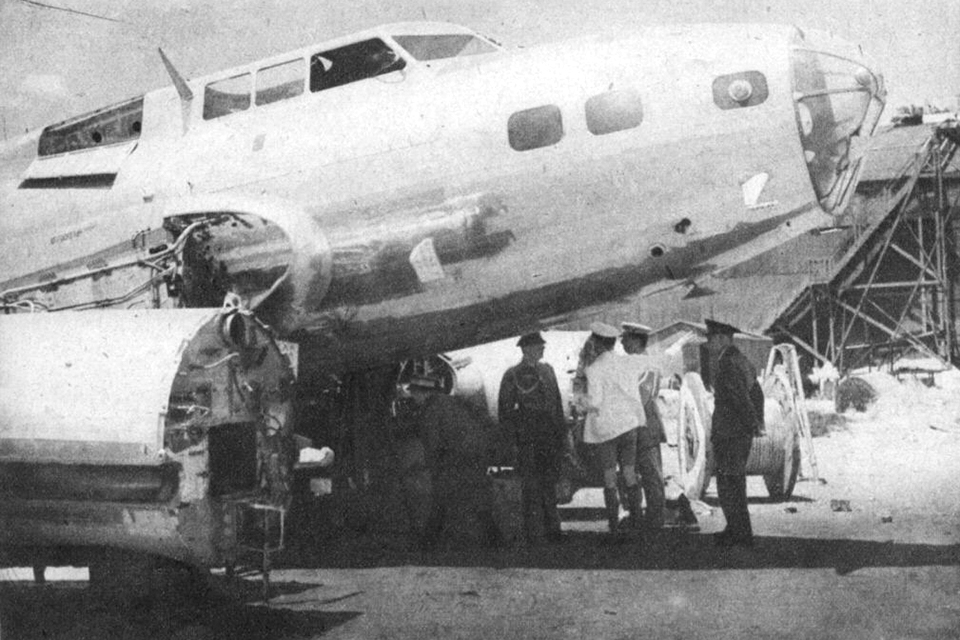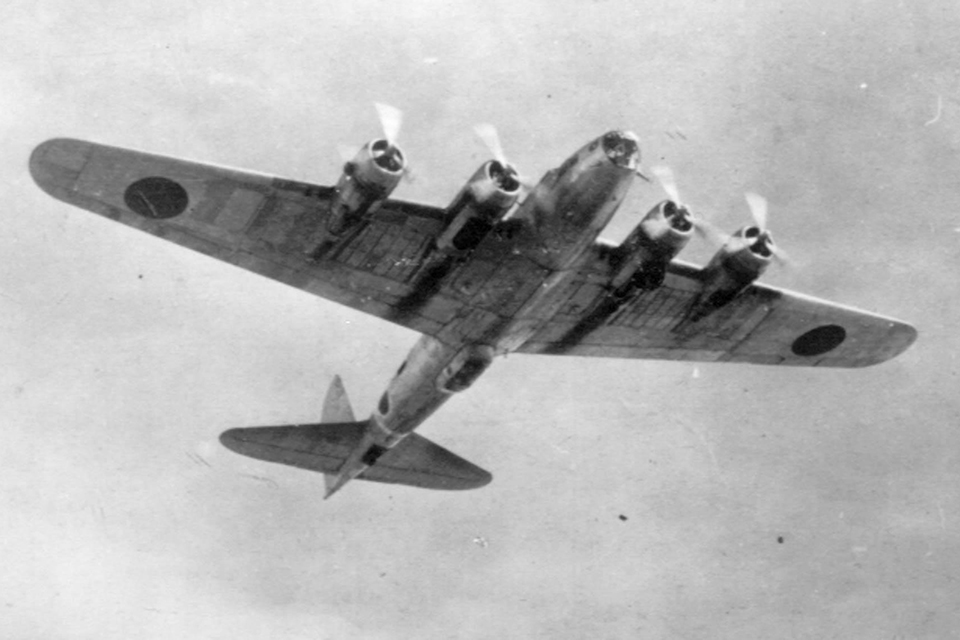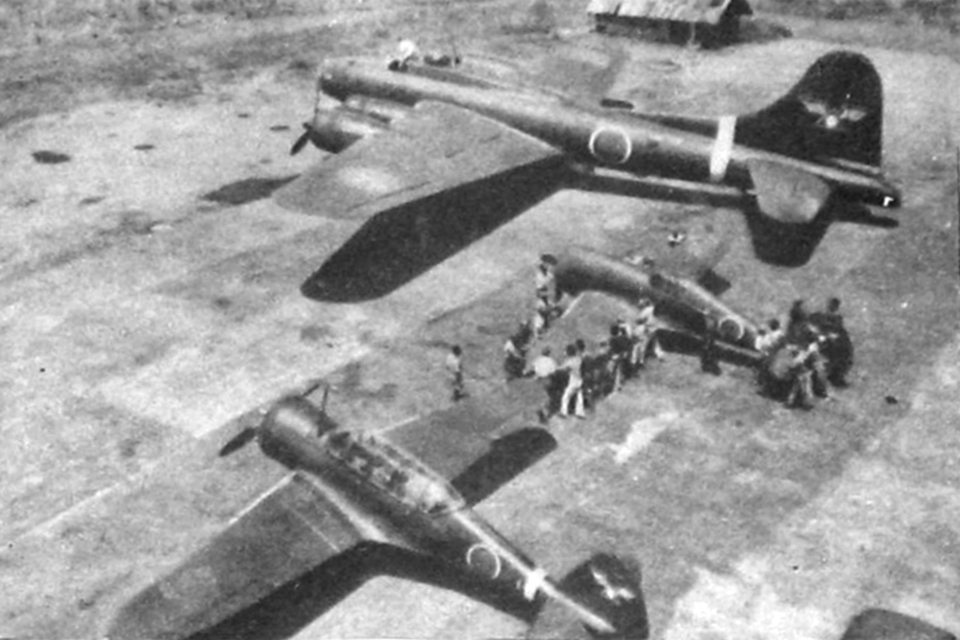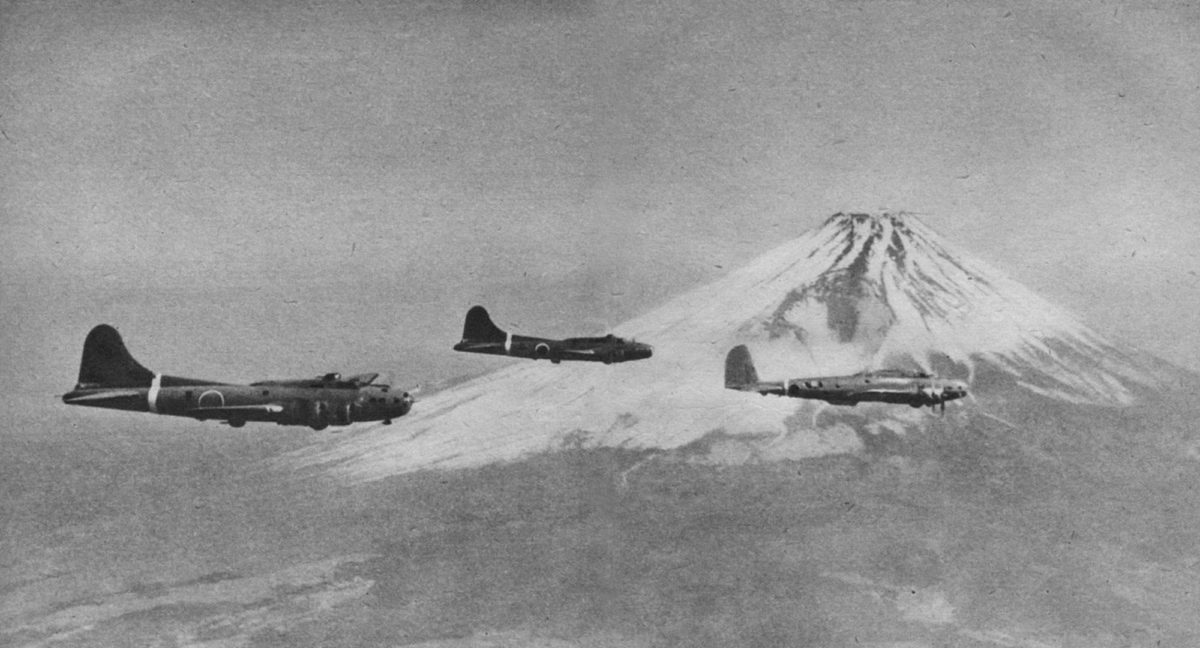In late May 1945, U.S. Army Air Forces intelligence officers were intrigued by the results of a photoreconnaissance sweep over an airfield near Tokyo. Clearly visible in photos of Tachikawa, home base for Japan’s Army Aviation Technical Research Institute, was what seemed to be a new type of Japanese four-engine bomber or transport.
The Tachikawa photos raised a fair number of eyebrows—especially considering that Japan’s aircraft industry was then taking a fearful pounding from B-29 Superfortresses, seriously curtailing production. Analysts reckoned the airplane’s wingspan was about 104 feet, which led to its being code-named “Tachikawa Field 104.” As weeks passed, however, no new information came to light about the mystery plane. None of the American analysts who saw the images suspected the truth—that it was actually one of their own aircraft, a Boeing B-17E Flying Fortress.
By noon on the first day of the war, some three and a half years earlier, most of America’s strategic air power in the southwest Pacific had lain in smoking ruins at Clark Field in the Philippines. In October 1941, 35 B-17Ds of the 19th Bombardment Group, fresh from the factory only a few months earlier, had reached Clark Field. Two squadrons were deployed to Del Monte Field on Mindanao, 600 miles south of Clark, and thus escaped the initial devastation, which took place a few hours after the surprise attack on Pearl Harbor.
Of the 17 Forts at Clark, not one remained flyable after the attack, and most had been reduced to rubble. By scavenging—taking a wing here, a tail there and undamaged engines from elsewhere—resourceful GI mechanics managed to piece together three more or less complete aircraft in the attack’s aftermath. But their valiant efforts were largely in vain, since the Japanese continued their air assault, which was soon followed by troop landings to the north at Lingayen.
By December 10, only 18 B-17s were left in the entire 19th Group, and of those just 12 remained operational. The surviving bombers were ordered south to Australia. Orders were issued for all the unflyable aircraft left at Clark to be destroyed, and on December 26, the field was abandoned to the advancing enemy.

In the wake of the Japanese occupation, a team of experts arrived from the Giken, the Army Aviation Technical Research Institute, hoping to find clues about the latest American equipment. As they set about surveying the wreckage and collecting fragments of planes and weapons, their attention centered on the Flying Fortress. Pictures of the latest model, the B-17E, had already appeared in Japanese publications as early as the previous August (about the same time the American public first saw them). No B-17Es were found at Clark, but the Japanese did make some valuable discoveries, including the turbosuperchargers on the wrecked B-17Ds. In the end, they began collecting all the salvageable parts they could find, in hopes of doing just what the American mechanics had done: put together a flyable B-17.
Their efforts paid off later in 1942, when a pieced-together Fort roared down Clark’s runway and rose majestically into the air, headed for Japan. A special aircrew had been sent from the Home Islands for this important mission. Although the bomber still carried its U.S. serial number, 40-3095, the Army Air Forces insignia had been painted over with the Rising Sun emblem to identify its new owners.

In March 1942, the last U.S. bomber escaped from Java ahead of the Japanese onslaught. The Dutch then destroyed the airfield. The wrecked aircraft left behind seemed nothing more than worthless scrap to the Allies, but to the Japanese it was more building material. At Java they found the remains of 15 B-17Es. Encouraged by their success with the D model rebuilt at Clark, they started in on an E model. With the help of captured Dutch and native mechanics who were pressed into service at the airfield, the Japanese technicians faced the challenge of unsnarling the B-17E’s advanced systems.
At Madioen Field the Japanese found a B-17E, serial number 41- 2471, that was in good condition aside from a missing nose and engines. Another E model, nicknamed Pootsie, was found in repairable shape at a nearby field. In fact, Torao Saito, an aviation editor from Asahi Press who toured Java’s captured bases, counted four B-17Es then being readied for flight, one at Malang, another at Cheribon and two more bombers at Bandung.
“The maintenance facilities for the B-17 in Java were excellent for that time and existing conditions,” Saito wrote. “It appeared that Bandung Field was the main maintenance base for the Americans, and it was here that our technicians from the Giken performed their initial flight evaluation tests on these newest of American war birds.”
Asahi’s aviation magazine, Koku-Asahi, ran an article in its May 1942 issue on the B-17 by Mitsubishi engineer Hisanojo Ozawa, designer of two of Japan’s twin-engine army bombers, the Ki-21 and Ki-67. Ozawa seemingly dismissed the latest version of the Flying Fortress, stating: “The B-17E was merely modifications made to an old design that first flew in 1935. Martin B-10s and Handley Page Heyfords of the same vintage as the original design of the Fortress had already been phased out of service.” But Ozawa did admit that the B-17 was based on an extremely good design, and he also said that improvements had made it a first-line combat aircraft.
In a similar article, Shizuo Kikuhara, the designer of the four-engine Kawanishi H8K flying boat, was impressed by the simplicity of the B-17’s cockpit, considering the plane’s size. He wrote: “The American engineers have perfected the subsystems of this bomber to such a degree that a minimum of controls are needed in the cockpit. This feature aids in-flight control simplification and allows the pilot to turn his attention to other tasks that can be critical in combat situations.”
By the end of 1942, two B-17s had been rebuilt and flight-tested in Java. As the two Forts were being readied for the long trip back to Japan, elaborate flight plans were prepared, routing them by way of Singapore and alerting the air defense system so they would not accidentally be shot down en route. Escorted by fighters, and with the Nakajima-built equivalent of a C-47 acting as mother ship, the B-17s reached Tachikawa Air Base in May or June 1943. No sooner had they landed than technicians swarmed over the bombers.
Heading the staff that would test the rebuilt B-17s was aeronautical engineer Major Kazuyuki Saito of the Imperial Japanese Army Air Force, assisted by Lieutenant Shioyama, Lts. 2nd Class Kurusu and Ohara and army assistant engineer Shimamura. This team oversaw the entire evaluation project, which encompassed all systems testing. Major Uno and Captain Yagi served as pilots for a series of test flights, while army engineer Kaneko conducted detailed studies of every engine component and related systems. A number of components were also sent to experts for further study and evaluation.
One of the B-17Es served as test-bed for a captured Norden bombsight, coupled to the Sperry automatic flight control system. Also of great interest was the B-17’s gunnery equipment, especially the Sperry automatic computing gunsight.
In February 1943, Asahi Press published a book, Anatomy of the Enemy’s Aircraft, that included many photographs of captured Allied airplanes, with special attention given to B-17s, both the D and E models. That May Koku-Asahi again devoted almost an entire issue to the captured B-17s. Nearly every major component was shown in photos and drawings. Since the Japanese also had instruction manuals for the aircraft, no detail was overlooked.
Interestingly enough, the extensive B-17 evaluations seem to have had very little impact on Japanese bomber design. Aside from Japan’s near copy of the Douglas DC-4E as a bomber—the Nakajima G5N—its other four-engine land-based bomber, the Nakajima G8N, which entered production toward the end of the war, was more advanced in terms of its structural design and gained nothing from the B-17’s airframe engineering.
There is some evidence, however, that the B-17 influenced components and systems in later Japanese aircraft. Most noteworthy were the unsuccessful attempts to perfect the turbosupercharger. A handful of well-designed airplanes, including the army’s Tachikawa Ki-74, Mitsubishi Ki-83, Nakajima Ki-87, Mitsubishi Ki-109 and others, as well as the navy’s G8N and Mitsubishi J2M, failed to reach their full potential mainly because of Japan’s inability to improve engine performance with turbosuperchargers. The Japanese clearly had the engineering knowhow to produce an efficient turbocharged engine for these aircraft, but they lacked the necessary materials.
By Japanese standards, the B-17’s fire-control system was very advanced. The navy perfected such a system for its G8N. Another improvement based on the B-17 was the development of an automatic computing gunsight for fighter aircraft.
When it came to evaluating the Norden bombsight, both the Imperial Army and Navy found that the stabilization method in their own bombsight was superior to that of the Norden instrument. By combining characteristics of the two, the Japanese came up with a far better bomb-aligning instrument.
In the final analysis, while the B-17 tests did give Japanese engineers a technical advantage, poor production, inadequate materials and, finally, the war’s conclusion prevented any significant combat application of their research.

In the fall of 1943, all three Fortresses were moved to Fussa Airfield (now the U.S. Air Force’s Yokota Air Base) near Tachikawa, where the Japanese army tested most of its aircraft. Two of the B-17s also visited Hamamatsu, the main heavy bomber base, in June or July 1944. Their specific mission there is unknown, but it probably involved further comparisons with the Japanese bomber fleet.
In addition to their use in testing, the Forts often appeared in military training films. One such film demonstrated combat tactics used by Nakajima Ki-43 pilots against the American bomber. The B-17D, once again embellished with U.S. insignia, showed up most frequently in these movies, sometimes escorted by a captured Curtiss P-40. The films often played in Japan’s public theaters during the war years.
Early in 1944, while one of the E models was beginning its takeoff roll for an evaluation flight out of Fussa, a sudden crosswind caught the bomber before it reached full rudder-control speed. The pilot lost directional control, and the Fort left the runway, its right wing smashing into a parked Nakajima Ki-49 heavy bomber. The B-17 sustained such severe damage that it never flew again. After the war ended but before Allied occupation forces reached the Home Islands, recon photos showed a B-17 at Irumagawa Airfield (later renamed Johnson Air Base), just north of Fussa. The plane was not on the flight line at the time but parked at a spot that was accessible to student officers attending the Toyooka Shikan Gako, Japan’s air force academy. This aircraft may have been the damaged Fortress.
A second B-17 showed up in recon film of Tachikawa around that same time. But when another survey flight took place nine days later, the Fort had vanished.
The third captured bomber’s location was never pinpointed, but it could have been lost during a hangar fire at Tokorazawa Airfield late in the war. The Japanese had collected a number of airplanes at Tokorazawa, including a German Junkers Ju-87 Stuka, a Mitsubishi Ki-20 (a four-engine bomber dating from the mid-1930s) and others, apparently intending to display them at a museum. One of the B-17s might have been included in that collection, but its presence there has never been confirmed. No Fortresses showed up in recon film of Fussa shot at war’s end.
Of the thousands of aircraft photographs taken during Japan’s occupation, no known photos of the B-17s from that time exist today. Records of the Strategic Bombing Survey make no mention of having located any B-17s, yet they do note that B-17s had been evaluated by the Japanese military.
Why and how did the American bombers disappear at the end of the war? More than six decades after Japan’s surrender, the fate of its little fleet of B-17s remains a mystery.
Robert C. Mikesh is the former senior curator for the National Air and Space Museum. Prior to joining NASM in 1970, he served for 21 years as a U.S. Air Force pilot. He has researched Japanese aviation since the 1950s, and is the author of many books and articles on the subject.
This feature originally appeared in the July 2010 issue of Aviation History. To subscribe, click here.





